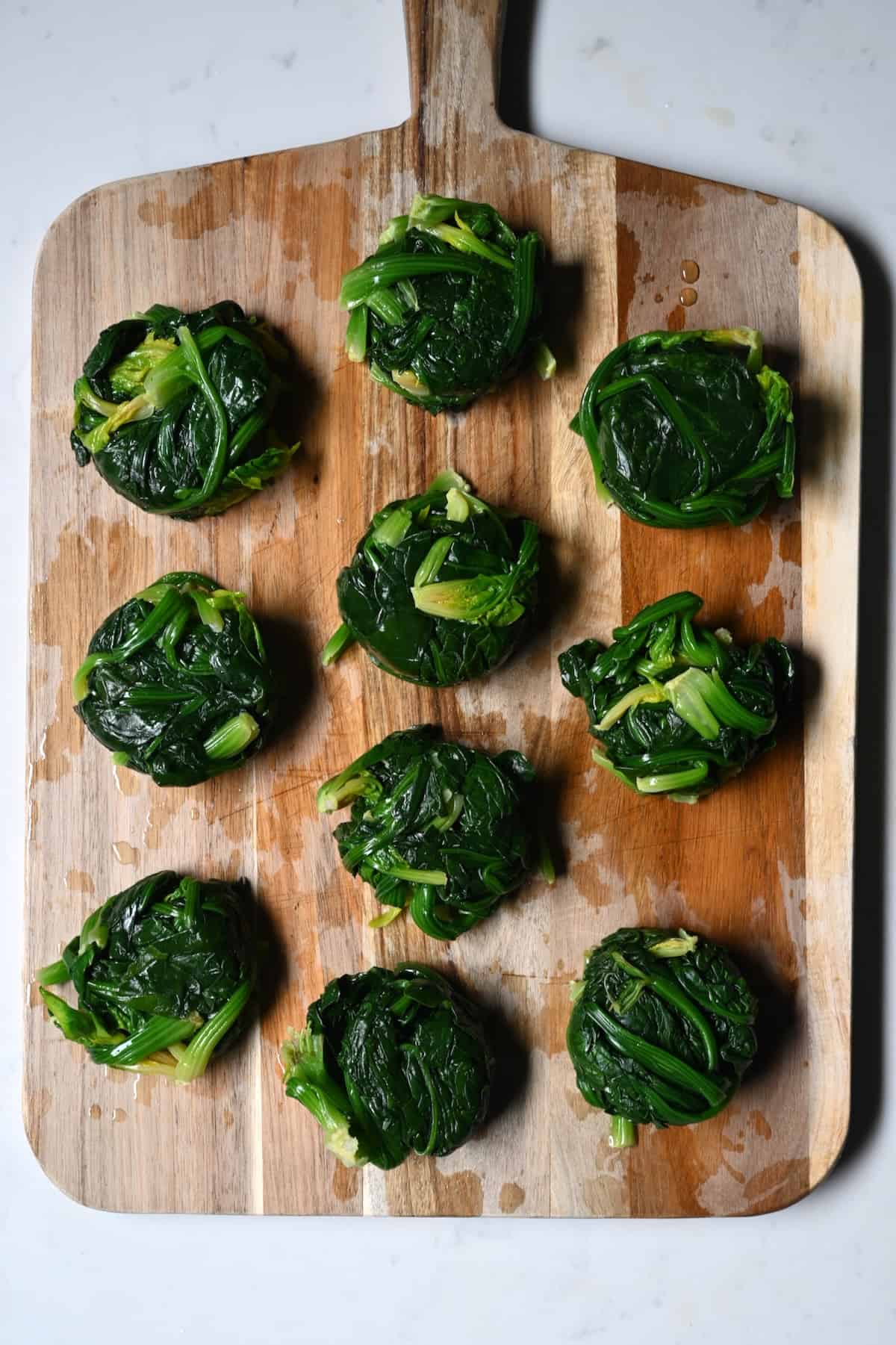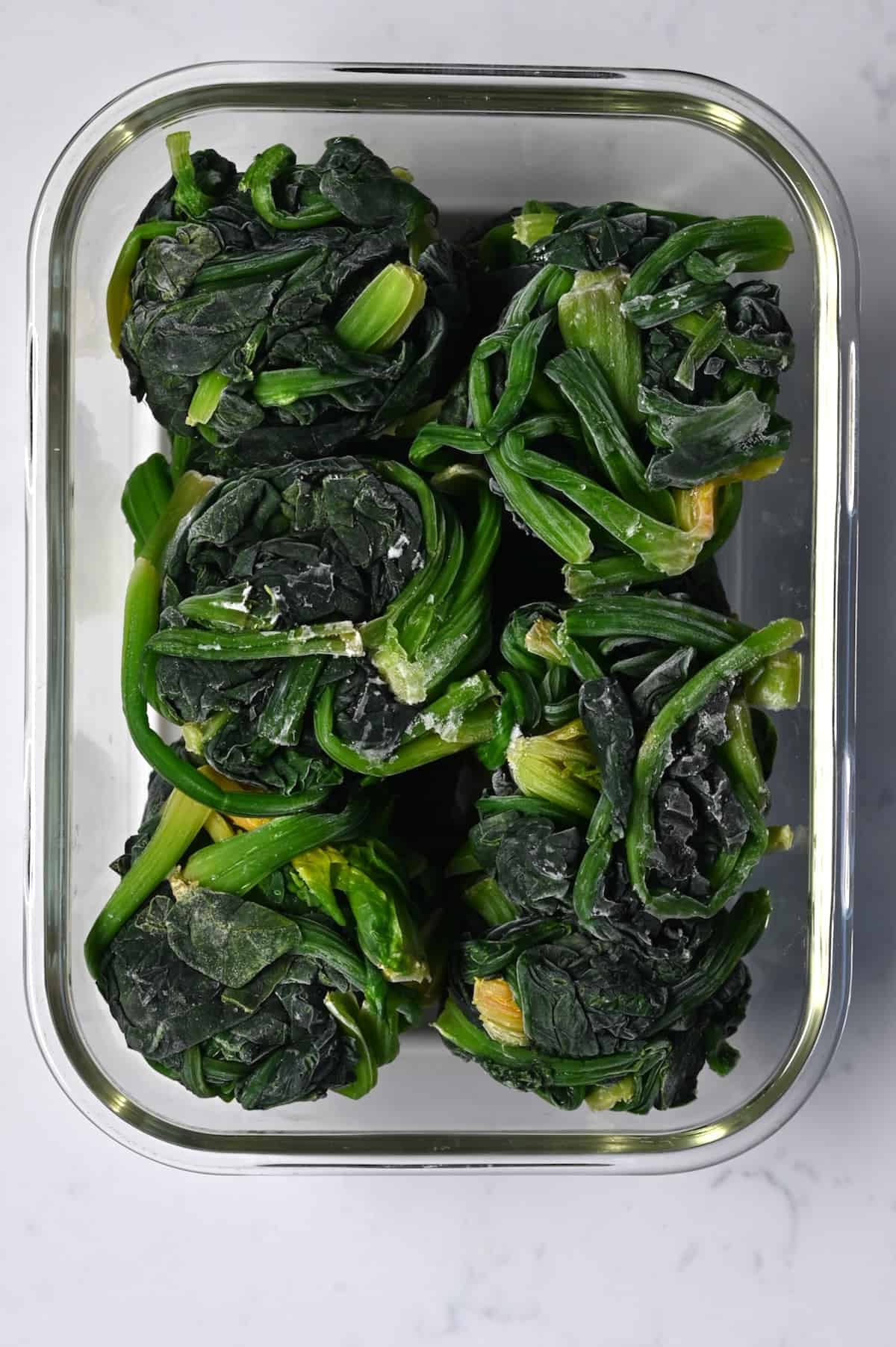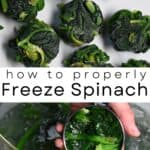This post may contain affiliate links. Please read our disclosure policy.
Though their prime season is the spring and summer, knowing how to freeze fresh spinach can keep your plate packed full of greens – and goodness – all year long.

Among all the superfoods, spinach is one of the kings. It is packed full of essential nutrients. Plus, it’s also a versatile ingredient that can add a veggie boost to almost any dish. So knowing how to freeze spinach to enjoy it all year long – without getting soggy leaves – is something of a skill.
Are you looking to cut down on waste? Do you want to keep these essential vitamins in your diet even when they’re out of season? Then knowing how to most effectively freeze spinach will ensure your plate stays colorful – even when it’s grey outside.

You partially cook, then freeze spinach, locking in all of the essential nutrients this leafy green has to offer. So, knowing the best way to freeze spinach will ensure you get plenty of goodness. Even when fresh spinach has gone out of season.
Want to save this recipe?
Why Blanch Spinach Before Freezing?
When it comes to spinach, the last thing you want is wet leaves that disintegrate when you try to defrost them. Or leaves that lose their taste and texture after they’ve been frozen. But can you freeze it without blanching it? Or can you just throw it in the freezer if you’re squeezed for time?
Blanching is a technique whereby a vegetable is partially cooked for a few minutes, then dunked into ice water. It’s most frequently used to retain the color and taste of vegetables that can get easily lost during the cooking process. Blanching will also preserve the enzymes that will keep your frozen food tasting fresh, even months after it was stored.

When it comes to how to freeze spinach, blanching is the most practical option. Blanched spinach will keep in the freezer for up to a year. Plus the process also partially wilts fresh spinach. So it’s much easier to pack into freezer-safe bags or containers when it’s time to store.
If you want to freeze the leafy greens and are short of time, you can do it without blanching. Though be warned, this will result in a smaller overall yield of leaves. As it defrosts, the non-blanched spinach will release more water and give you a smaller portion.
How to Wash Spinach
With its distinctive dark green color, it can be difficult to know when fresh spinach leaves are thoroughly cleaned.
Using a colander – or just your sink – wash the leaves and stems under running cool water, removing any debris and dirt. If you’re using long-stemmed spinach or with roots, trim them before continuing.

How to Blanch Spinach
Before you begin, prepare a large bowl of very cold water and ice.
Bring a large pot of water to a boil. Place the spinach in the boiling water and blanch it for two minutes. Once the time is up, immediately plunge the spinach into the bowl of ice water for 2-3 minutes. This will instantly stop the cooking process while preserving the color and taste.

Drain thoroughly after cooling. Pat the spinach dry with a kitchen towel or paper towel. You can also use a salad spinner.
You want to make sure there’s no extra moisture hanging around. This can cause a loss of quality as you freeze spinach.
How to Freeze Spinach
To freeze it most effectively, you should divide it into smaller portions.
I like to make small balls so I can take them out and defrost them at my leisure. You can make the balls using a measuring cup (1/2 cup or a little bigger if wanted). You can also freeze in ice cube trays – especially large ones.
Place the blanched spinach leaves into the cup, squeeze out any excess water, then press down to condense the leaves together. Then, remove using a knife around the edges so it comes out clean.

Flash-freeze the balls (or spinach cubes) on a flat surface, not touching, for a few hours or overnight. Once they have hardened (not necessarily fully frozen yet), place them into freezer bags or airtight containers. Press out as much air as possible from the bags and seal them tightly to avoid freezer burn.
How Long Does Spinach Last in the Freezer
Label your bags with the date and place them in the freezer. Frozen cubes of spinach can last up to 8-10 months.

How to Thaw Frozen Spinach
You know how to freeze spinach – now you need my handy guide for defrosting.
To use your frozen spinach, remove the desired portion from the freezer. Thaw it in the refrigerator overnight or you can also defrost it at room temperature for a few hours. If you’re in a hurry, you can even thaw the spinach in the microwave on the defrost setting.
You can then use the frozen and thawed spinach in your favorite recipes. Like in this delicious artichoke spinach dip, and rich creamed spinach. You can add it to soups, stews, smoothies, pasta dishes, and more.
More Ingredient Tutorials
- Artichoke and How to Cook It
- What Is Arugula and What to Do with It
- Fennel and How to Cook It
- Sauteed Swiss Chard
If you try this recipe, let me know how it goes in the comments below. I’d appreciate a recipe card rating and would love to see your recipe recreations – tag me on Instagram @Alphafoodie!

How to Freeze Spinach (The Best Way!)
Ingredients
- 10 oz spinach 8 cups, or as much as wanted
Instructions
- Wash the leaves and stems under running cool water, removing any debris and dirt. If you're using long-stemmed spinach or with roots, trim them before continuing.
- Prepare a large bowl of very cold water and ice.
- Bring a large pot of water to a boil. Place the spinach in the boiling water and blanch it for 2 minutes.

- Once the time is up, plunge the spinach into the bowl of iced water for 2-3 minutes. This will instantly stop the cooking process while preserving the color and taste.

- Drain thoroughly after cooling. Pat the spinach dry with a kitchen towel or paper towel. You can also use a salad spinner to remove as much moisture as possible.
- Divide the spinach into smaller portions. You can make small balls using a measuring cup (1/2 cup or a little bigger if wanted). You can also freeze it in large ice cube trays.Place the blanched leaves into the cup, squeeze out any excess water, then press down to condense them together. Then, remove using a knife around the edges so it comes out clean.

- Flash-freeze the balls on a flat surface, not touching, for a few hours or overnight.
- Once they have hardened (not necessarily fully frozen yet), place them into freezer bags or airtight containers. Press out as much air as possible from the bags and seal them tightly to avoid freezer burn. Label your bags with the date and place them in the freezer.

Notes
Nutrition
Nutrition information is automatically calculated, so should only be used as an approximation.

















